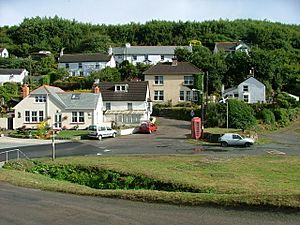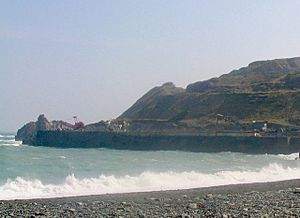Porthoustock facts for kids
Porthoustock is a small village, also called a hamlet, located near St Keverne in Cornwall, England. It sits on the eastern coast of the Lizard Peninsula. Nearby, people dig up rocks and minerals from the ground in quarries. Porthoustock beach has a large concrete building called a stone mill, which used to crush rocks but isn't used anymore. Big ships, up to 82 meters long, can come to the wharf (a special dock) at the beach to be loaded with stone. Fishermen also work from the shingle beach, catching lobster and crab using pots, or fishing with nets and long lines. The famous South West Coast Path, a long walking trail, goes right through Porthoustock.
Porthoustock is part of the Cornwall Area of Outstanding Natural Beauty (AONB). This means it's a very special place with beautiful scenery, just like a National Park. About one-third of Cornwall has this important protection.
Contents
A Look Back: Porthoustock's History
Porthoustock started as a quiet fishing village. But things changed around the 1890s when it became a busy port for the local stone quarries. People have been quarrying (digging for stone) in Porthoustock since the late 1800s. By the 1940s, a company called Amalgamated Roadstone owned the quarries. The stone from Porthoustock was even used to build Cornwall's airfields during World War II. Luckily, Porthoustock was bombed by German planes in November 1940, but no one was hurt.
Shipwrecks and Rescues
Porthoustock is very close to The Manacles, a group of dangerous rocks about 1 nautical mile (1.85 kilometers) east and southeast of Manacle Point. Because of these hidden rocks, many ships have crashed and sunk near Porthoustock. To help people in trouble, the Royal National Lifeboat Institution (RNLI) placed a lifeboat here in 1869. They built a special boat house by the beach. The lifeboat station closed in 1942, and the building is now the village hall. The last lifeboat stationed here was called the Kate Walker, which arrived in 1931. After it was sold in 1946, it was turned into a yacht. In 2007, it was seen at Felixstowe Ferry.
Rocks and Minerals: Porthoustock's Geology
The quarries in Porthoustock are known for several interesting minerals. These include Analcime, analcite, epidote, hornblende, prehnite, calcite, diorite, and pectolite.
The Giant's Quoits
There's a cool natural rock formation called the Giant's Quoits on the cliffs above Porthoustock. These huge rocks used to be on Manacle Point. But in 1967, they were moved to their current spot because the quarries were getting bigger.
The cliffs and quarries south of the village are part of the Coverack to Porthoustock SSSI. SSSI stands for Site of Special Scientific Interest, and this area is protected because of its important geology.
Porthoustock's Economy: Stone and Ships
The West of England Quarry, owned by Aram Resources, is right next to Porthoustock village. This quarry digs up a dark green rock called diorite. The quarry has its own wharf, which means they can load the stone directly onto ships. The wharf is protected from the strong Atlantic weather, so ships can usually be loaded without much trouble.
Diving Adventures
Porthoustock is a popular place for divers. Many divers launch their boats from the beach to explore The Manacles underwater. You can even get diving lessons here!
Images for kids





